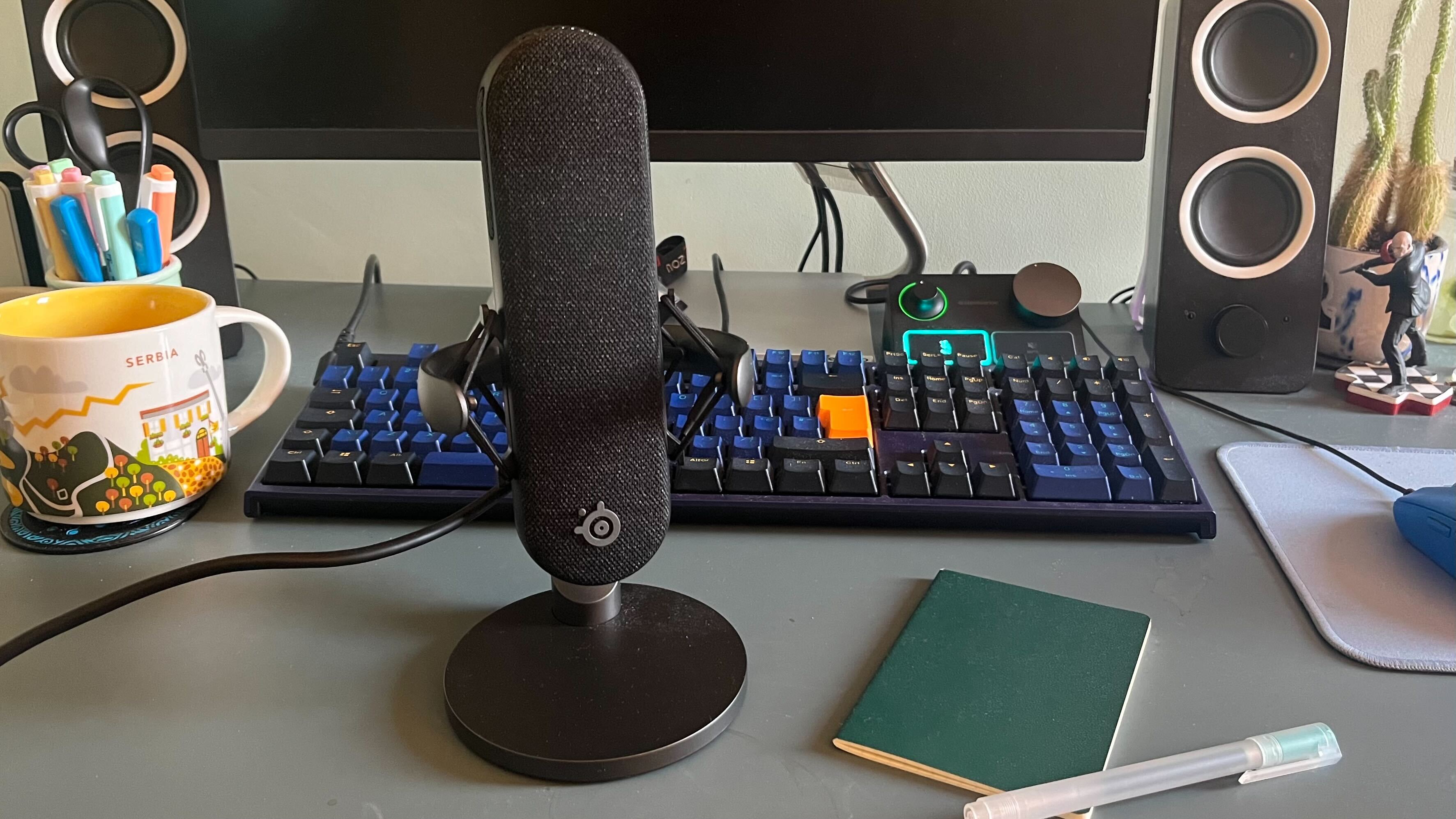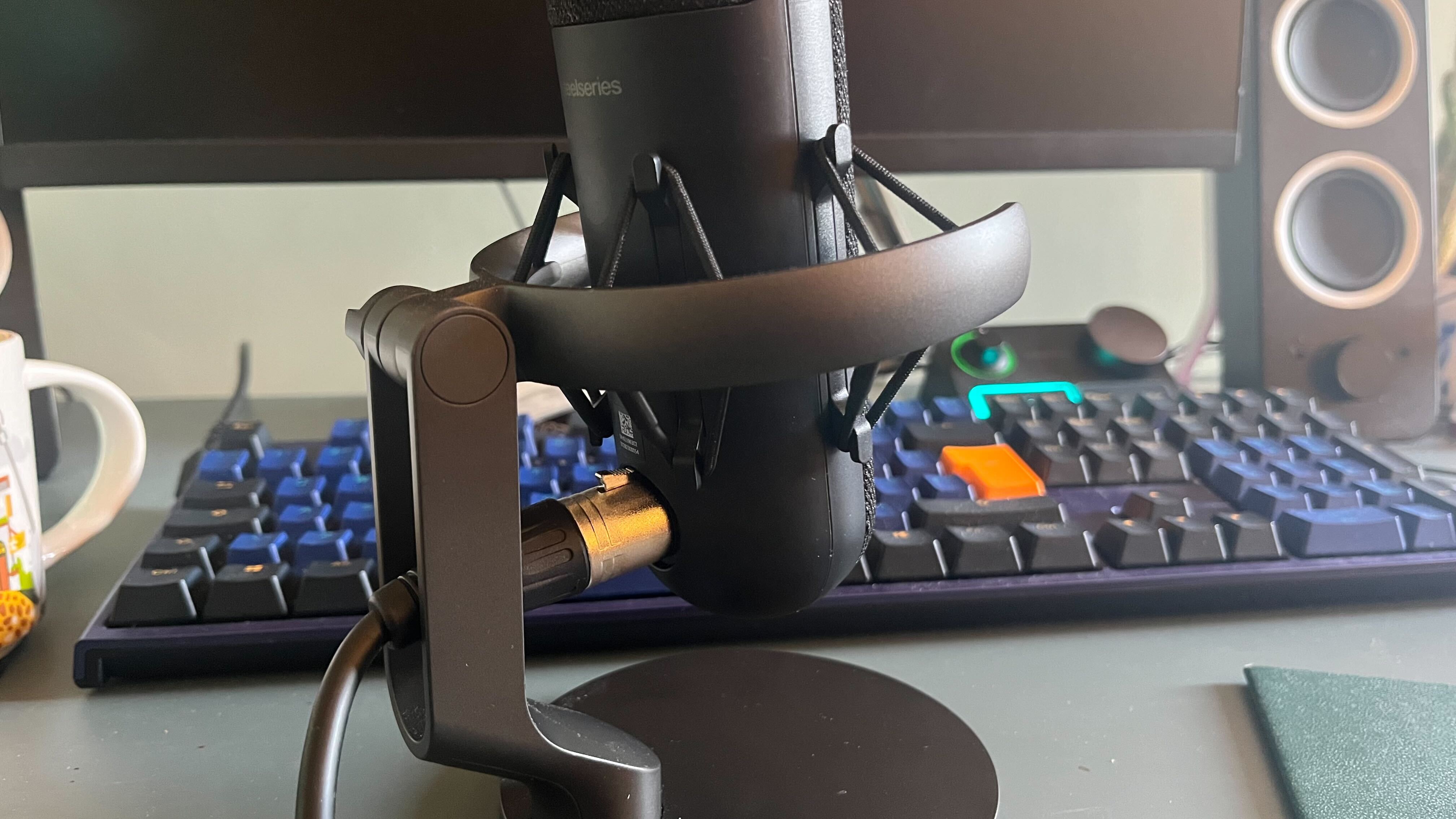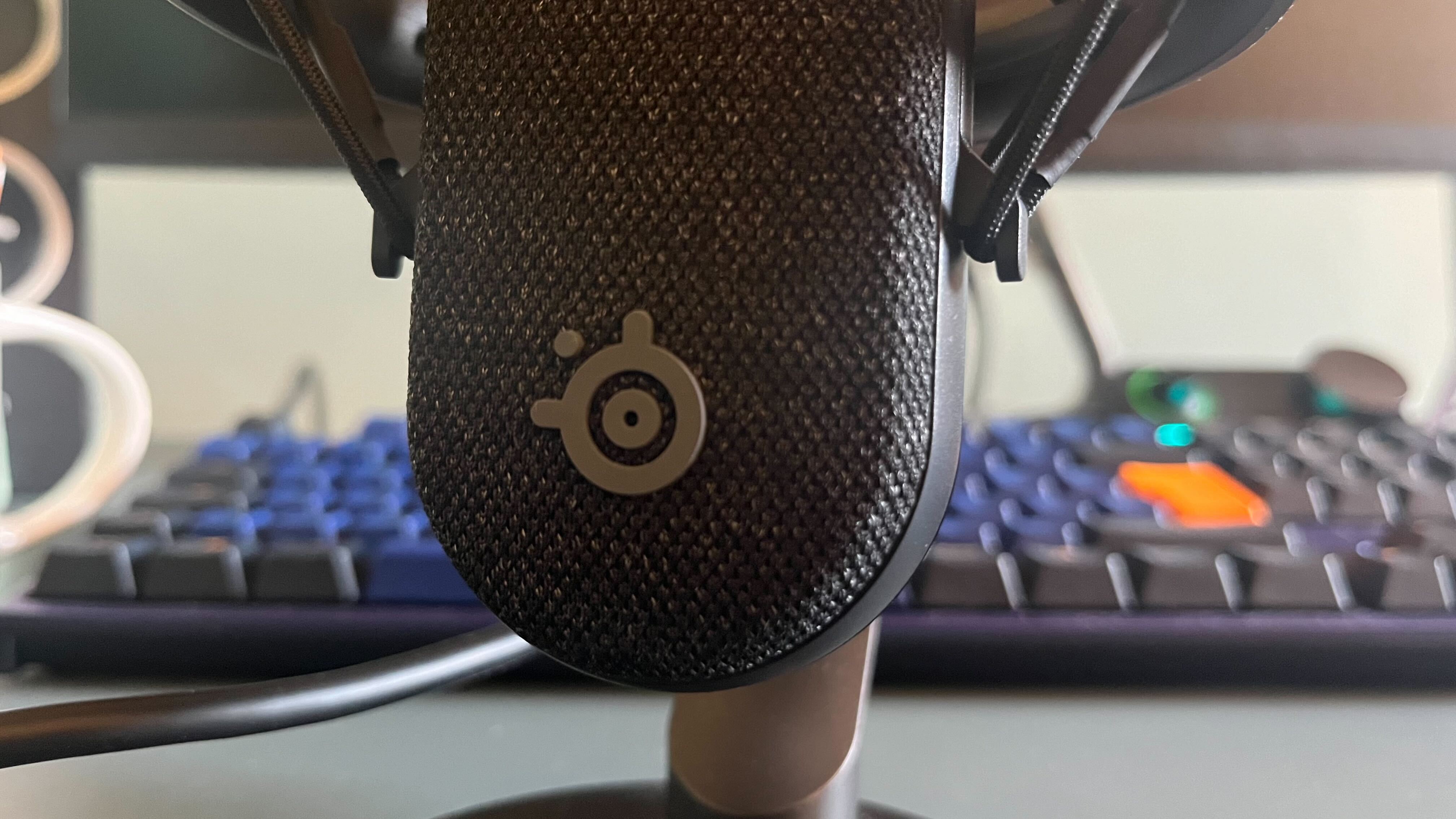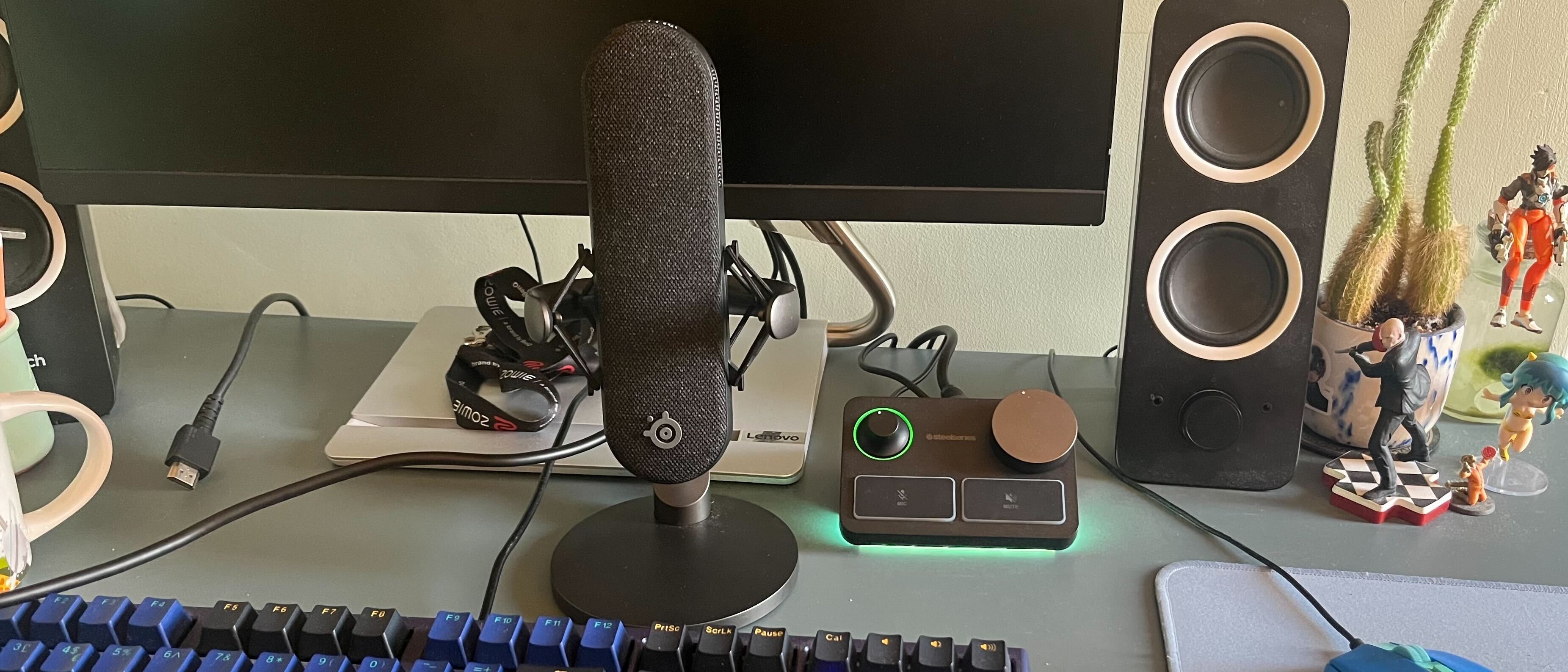TechRadar Verdict
The SteelSeries Alias Pro sounds absolutely incredible, making it a solid choice for all kinds of content creation ranging from game streaming to ASMR. An inaccurate gain indicator on the included stream mixer, however, alongside some minor design annoyances mean that it falls short of a glowing recommendation.
Pros
- +
Incredible sound quality
- +
Separate stream mixer
- +
Support for two PCs
Cons
- -
Inaccurate gain level indicator
- -
Mushy buttons
Why you can trust TechRadar
The more premium big brother of the SteelSeries Alias, an all-in-one microphone that we called a “very impressive debut” from the gaming peripheral manufacturer in our recent review, the SteelSeries Alias Pro is an extremely high-end microphone geared almost exclusively towards content creators and streamers.
Based on the same eye-catching design of the Alias, but with the addition of a separate stream mixer that also functions as its digital-to-analogue converter (DAC), the Alias Pro benefits from a higher-quality XLR connection. This helps deliver absolute top-of-the-range audio that will be suitable for everything from professional podcasting to a cheeky ASMR stream. While it has undeniably increased the audio quality, the move to a separate stream mixer does remove some of the convenience that we appreciated so much with the original model.
This version’s alternate placement of the gain indicator, which is now found as an LED ring around the gain dial itself, is also rather distracting in use, and the new style of microphone mute button feels unpleasantly mushy to the touch. The gain indicator itself is also rather inaccurate, failing to reliably reflect when sound is actually being broadcasted. This is a major disappointment in such an expensive device and, for all the impressive audio quality, could be a serious deal-breaker depending on your needs.
SteelSeries Alias Pro - Price and availability
With a seriously high asking price of $329.99 / £319.99 / AU$699, the Alias Pro is one expensive microphone at least when you compare it to any of the usual cheaper USB alternatives commonly used by streamers. When it comes to the world of the more professional XLR microphone, where the use of an analog connection ensures far greater audio quality, this is actually a fairly modest price tag when you take the usual cost of a complete XLR setup into consideration.
A quality XLR microphone from a trusted audio brand like Rode generally costs substantially more than the $200 / £150 / AU$280 mark and that’s before you factor in the price of a separate DAC, which is necessary to use the microphone with your PC. Those generally run above the $100 / £80 / AU$150 range at the very least, so all things considered you’re not paying substantially more for a visually attractive all-in-one package here.
The Alias Pro can be found on sale via the SteelSeries website or at Amazon in both the US and UK. Several other retailers also stock the microphone in the US, such as Best Buy and Walmart. Like the Alias, the Alias Pro is a little harder to find in Australia at the moment, but is currently in stock at JB Hi-Fi if you’re willing to pay a little more than other regions.
SteelSeries Alias Pro - Design and features

Making use of much of the same visually appealing design elements as the stunning SteelSeries Alias, the Alias Pro is a very attractive product especially when compared to the more utilitarian designs common with other XLR microphones. With a sleek black pill-shaped capsule covered in a soft fabric and adorned with an understated rubber SteelSeries logo, this is a microphone that’ll improve the look of almost any setup. This is particularly significant in the world of content creation and, if you frequently make use of a facecam, a microphone’s aesthetics can be just as important as the overall performance.
Sign up for breaking news, reviews, opinion, top tech deals, and more.
The use of metal and smooth plastic lend everything from the capsule to the stand a suitably premium feel that certainly reflects the cost. Unlike the Alias, however, the microphone itself is only half of the story. All of the control features, like the microphone mute button and gain dial, have been moved over to a separate stream mixer. This mixer has similar high-end materials and is surprisingly compact, making it easy to nestle underneath one of the best gaming monitors. Although the microphone itself has a lone XLR port on its rear, which connects to the DAC in the stream mixer, there is no shortage of interface options on the mixer itself.

The back features two USB-C inputs (which allow the mixer to be used with two separate PCs at the same time), alongside a clicky power button and a 3.5mm jack for audio monitoring. Another 3.5mm audio jack is located on the left hand side of the mixer too, this one intended as a general audio output for your speakers or headphones. The front of the mixer features a gain dial, surrounded by an RGB LED ring, and a larger volume knob above two big buttons - one is for microphone muting and the other for audio output muting.
Both buttons also feature RGB and can be illuminated with a choice of colors to reflect their current status. This is, unfortunately, a very necessary feature as the buttons themselves are incredibly mushy and require quite a bit of force to properly activate. During my use, there were a few frustrating occasions where it took a second, more firm press for the microphone mute to kick in which, while not the biggest issue, is a disappointing oversight given the cost.
Finally, the stream mixer of the Alias Pro features a bright RGB strip on its underside which is a major improvement on the comparatively lackluster RGB ring of the Alias. It features the same solid range of customization options too and the added visual flair seems entirely appropriate given the streaming focus.
SteelSeries Alias Pro - Performance

The performance of the microphone itself is absolutely phenomenal. As you would expect from a pricey XLR microphone, it boasts simply incredible audio quality that sounds professional-grade with minimal software tweaking out of the box. This will be more than enough for the vast majority of content creation needs but especially shines when you’re recording locally and not constrained by the bandwidth or encoding limitations inherent in streaming. Although there’s only a single pickup pattern, it is very effective and proved more than enough to pick up my voice in any position around my desk; provided that I remembered to adjust the gain appropriately.
Although a microphone with a dedicated omnidirectional polar pickup pattern may be more appropriate for larger groups, I found the SteelSeries Alias Pro was comfortably able to record multiple voices without any serious issues, ensuring that everyone remained heard which should also make it a viable option for those who want to podcast as well.
Unfortunately, the stream mixer itself suffers a few noticeable issues. In addition to the mushy buttons, the gain meter on the module seems incredibly inaccurate at times. Like the Alias, it uses a traffic light color system by default (starting at green when volume levels are normal before switching to amber or reaching red if the input is too loud). Even with multiple attempts at adjustment, however, I could never find the setting where the microphone accurately reflected the lower end of the spectrum.
There were numerous occasions where my voice was perfectly audible in a recording or online call but failed to register as a visible input on the gain meter, which may prove a dealbreaker for some. While the gain meter will still tell you if you’re too loud, it can’t reliably provide that baseline level of reassurance that you’re broadcasting at normal levels.
As noted in my SteelSeries Alias review, the recommended SteelSeries Sonar software (which is used for both models) is also a bit of a mixed bag. It works well as a general volume mixer and an easy method to control the inputs when you’re making use of the SteelSeries Alias Pro’s dual PC support, but intrusive features like automatic game recording continue to frustrate.
Should I buy the SteelSeries Alias Pro?

Buy it if...
You want a flashy XLR microphone
As far as XLR microphones are concerned, the SteelSeries Alias Pro is one of the most visually appealing that we’ve ever tested. If you want to buy an XLR microphone that will help you stand out from the crowd, its sleek design and solid RGB will do the trick.
Audio quality matters the most to you
Although they’re much more expensive than USB alternatives, an XLR microphone can provide some of the best audio quality around. Consider the SteelSeries Alias Pro if you want a product from a gaming brand that will sound great without much tweaking.
Don't buy it if...
You intend to rely on the gain meter
The unreliable gain meter is a major letdown and could seriously impact your experience. Other premium options, including the far cheaper SteelSeries Alias, provide more reliable audio monitoring solutions.
You’re not a content creator
It goes without saying, but the Alias Pro really does live up to its Pro moniker. Many of the usual audio quality benefits of an XLR microphone are only really applicable to those who are professional streamers, video makers or podcasters. If that’s not you, save money and buy a more consumer-oriented product instead.
How we reviewed the SteelSeries Alias Pro
I used the SteelSeries Alias Pro as my primary PC microphone for well over a month. During that time, I used it for the majority of my online calls and tested its content creation capabilities by experimenting with audio recording software like Audacity. I also made sure to test its streaming capabilities in private streams to friends, who did appreciate the significant bump in quality compared to some of the other microphones I have lying around.
I endeavored to fully evaluate the features of the SteelSeries Sonar software too, tweaking settings and experimenting with all of the available options and features whenever I had the opportunity.
For more ways to upgrade your streaming setup, see our guides to the best microphones for streaming or pick for the best gaming desk available this year.

Dash is an experienced tech journalist who currently serves as the Gaming Editor at TechRadar, where he helps oversee coverage of video games and related products.
Before joining the team, he was Contributing Writer at PLAY (formerly Official PlayStation Magazine) and has also written articles for many of the UK's biggest gaming magazines including Edge, PC Gamer, and SFX.
Now, when he's not getting his greasy little mitts on the newest hardware or gaming gadget, he can be found listening to J-pop or feverishly devouring the latest Nintendo Switch otome.
